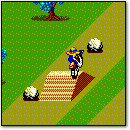Archive for the 'Retro Scan of the Week' Category
[ Retro Scan of the Week ] Quick, Illegal, and Wrong
Monday, December 10th, 2012 Piracy is as easy as hitting the Enter key on your numeric keypad.
Piracy is as easy as hitting the Enter key on your numeric keypad.
27 years ago, the industry group Association of Data Processing Service Organizations (ADAPSO) created this public service ad warning of the evils of software piracy. I’ve transcribed its text below — just so you don’t miss it.
It’s easy to make a copy.
It’s quick.
It’s illegal.
It’s wrong.It’s hard to believe.
People who wouldn’t think of shoplifting a software product on their lunch hour don’t think twice about going back to the office and making several illegal copies of the same software.
Making unauthorized copies of software is a violation of U.S. Copyright Law. Yet, the problem has reached epidemic proportions because many people are unaware, or simply choose to ignore the law. The software industry is urging decision-makers and software users to take steps to stop software piracy in their organizations. In the meantime, the industry has been forced to prosecute willful copyright violators.
There are legal, moral and economic imperatives forbidding theft of copyrighted software.
There is a free pamphlet on the subject. Call or write for a copy. A copy. A copy. A copy for everyone you know.
Please ask for Priscilla.ADAPSO
1300 North Seventeenth Street
Arlington, Virginia 22209
(703) 522-5055
“A copy. A copy. A copy. A copy.”
It really says that. I think it’s supposed to be a joke, albeit a very bad one.
ADAPSO changed its name to Information Technology Association Of America (ITAA) in 1991, although its supposedly current website is now owned by the International Trial Attorneys Association, so who knows if it even exists today.
Discussion Topic of the Week: What was the first piece of software you ever copied (or received a copy of) illegally?
—
See Also: Why History Needs Software Piracy (2012)
See Also: [ Retro Scan of the Week] Software Piracy (2009)
See Also: [ Retro Scan of the Week ] “What’s Wrong With Copying Software?” (2008)
See Also: Old-School PC Copy Protection Schemes (2006)
See Also: EGM Advertisement: Sell Famiclones, Go to Prison (2006)
[ Retro Scan of the Week ] Quickshot Joysticks
Monday, December 3rd, 2012 INSIST ON QUICKSHOT! THE GENUINE PIECE!!!
INSIST ON QUICKSHOT! THE GENUINE PIECE!!!
I own a few QuickShot joysticks, but I don’t believe I’ve used any of these particular models. Third-party console controllers weren’t all that popular in the age of the NES (relative to the 2600 days, at least), likely because the NES’s own pads (and the NES Advantage and Max) were so good to begin with. Same with the Genesis and Super NES. That fact alone probably killed a few third party video game peripheral companies that were hanging on from the Atari 2600 era, although the QuickShot brand lived on until the late 1990s.
Discussion Topic of the Week: Did/do you commonly use third-party controllers for your classic video game systems? Which one is your favorite?
[ Retro Scan of the Week ] The Cave BBS Turns 20
Monday, November 26th, 2012 A vintage printout of my first BBS log.
A vintage printout of my first BBS log.
Twenty years ago yesterday, I set up a BBS for the first time. The Cave BBS. Admittedly, it was nothing more than a bare-bones system run through Procomm Plus’ Minihost module Minihost, but it was a start. Within a few weeks (with a brief detour running VBBS for a few days), I had a full-fledged WWIV BBS setup running on a Tandy 1800 HD laptop with a 2400 BPS modem.
[Brief aside — I can’t find a copy of that ProComm Plus MiniHost for MS-DOS software anywhere — does anyone have it? I have the terminal emulator part, but not the MiniHost.] [ Update 11/27/2012 – Thanks to Jim Carpenter (see comments) for helping me find it! ]
[ Continue reading [ Retro Scan of the Week ] The Cave BBS Turns 20 » ]
[ Retro Scan of the Week ] Finally…a 1200 Baud Modem
Monday, November 19th, 2012You too could be the proud owner of this Radio Shack TRS-80 DC-2212 1200 baud modem for the low, low price of $399.95 (about $859.81 in 2012 dollars).
…If you traveled back in time with the proper currency, that is. But I wouldn’t recommend it.
I recently bought a cable modem that is the equivalent of a 150,000,000 baud modem. It cost $70 in 2012 dollars. Not bad for progress.
Discussion Topic of the Week: What speed was you first modem?
[ Retro Scan of the Week ] Nintendo Power Pad
Tuesday, November 13th, 2012 Nothing says fun like a nice hot bowl of chunky butter cubes.
Nothing says fun like a nice hot bowl of chunky butter cubes.
With the Wii U launching next weekend, it’s worth taking a look back the Power Pad, one of Nintendo’s first experiments in motion-based game control.
In this case, the controller (which decidedly lacked a second screen) took the form of a large vinyl mat with enormous soft buttons that one would lay upon the floor and beat with one’s fists stomp with one’s feet to simulate running in an on-screen video game.
It didn’t work too well, but I personally had a blast playing World Class Track Meet tournaments with the Power Pad at the neighbor’s house up the street. I recall playing in improvised teams of two, where one player from each team would stand and run on two of the forward facing buttons, and another player on each team would sit behind them on the floor and pound the rear buttons simultaneously in an attempt to make their character run faster.
This was apparently possible (I’m working from memory here — I haven’t used a Power Pad in a long time) because each column of buttons is linked together electronically in the Power Pad, so that a push on any one button in any one column is like a push on any other button in that column. Feel free to correct me if I’m wrong. I can’t test it because the Power Pad I happen to have doesn’t work.
By the way, I apologize for the uncharacteristically poor quality of the source material here. This came from a particular issue of Nintendo Power that I must have read hundreds of times, literally, so the creases are a natural byproduct of my youthful Nintendo-fueled enthusiasm.
Discussion Topic of the Week: Tell us your Power Pad memories. Have you ever used one?
[ Retro Scan of the Week ] A 1985 Solid State Drive
Monday, November 5th, 2012Back in January, I traced the evolution of the Solid State Drive from its 1978 origins to the present in a PC World slideshow. From that experience, I learned that SSDs, as a product class, were far older than most people realize.
Case in point: Seen here is an advertisement for a 1985-era SSD called the SemiDisk. The company behind this early SSD, SemiDisk Systems, sold a wide range of “disk emulators” (as they were called back then) for platforms like S-100 bus systems, the TRS-80 Model 2, and the IBM PC. All of them used solid-state RAM chips to achieve read and write speeds far beyond those of rotating platter drives at the time.
The 2 megabyte SemiDisk for the IBM PC retailed for $1,795 in 1985. That’s about $3,860 today when adjusted for inflation. Amusingly, at that vintage price rate — about $1,930 per megabyte — a 256 GB SemiDisk SSD would cost over $494 million today. Yep, that’s a 494 followed by six zeroes.
Of course, you can buy a 256GB flash-based SSD right now for under $180. Not bad.
Discussion Topic of the Week: When did you buy your first solid state PC drive? How big was it?
[ Retro Scan of the Week ] Dr. Chaos
Monday, October 29th, 2012VC&G’s Retro Scanner Breaks
Tuesday, October 23rd, 2012 As a small administrative note, I’d like to mention that the scanner I’ve used for our Retro Scan of the Week column since its inception in 2006 crapped out on October 15th, 2012.
As a small administrative note, I’d like to mention that the scanner I’ve used for our Retro Scan of the Week column since its inception in 2006 crapped out on October 15th, 2012.
It up and died. The scanning head got stuck a few times, then the scans started returning blank white images. It’s the digital equivalent to coughing up blood.
I’ve used the scanner, an Epson Perfection 2480 Photo, to scan thousands upon thousands of images, so it’s amazing it has lasted this long. It would be amusing to see how many miles the scanning mechanism has traveled since I first received the scanner as a gift from my dad in 2004 or 2005.
I might be able to fix the unit, but I thought of a better solution. My father happened to have the exact same scanner model, which he hasn’t used in many years. I picked it up on Sunday, dropped it in place of the old scanner, and it’s like nothing has changed. So Retro Scan of the Week is saved.
Of course, new flatbed scanners cost about $50 these days, so it may be time for an upgrade. I’ll think about it, but for now, the Epson Perfection 2480 Photo rides again!
[ Retro Scan of the Week ] Baked Apple II
Monday, October 22nd, 2012 Two hours later, firefighters found Fluffy melted into the plastic.
Two hours later, firefighters found Fluffy melted into the plastic.
(click image to see the full two-page spread)
There was a fire.
And a cat.
The computer melted.
A Beautiful Computer.
Oh, the curt, pretentious voice projected by Apple advertising in the 1980s. It almost revels in talking down to you. Just about every Apple print ad of the era uses a similar subliminal script. It goes a little something like this:
This is Apple.
We are amazing.
Really.
Don’t get me wrong — I like Apple as much as the next guy, but man, wipe that smirk off your face.
Apple has come a long way since that time, from floundering near death to basking as the most valuable corporation in the world. The firm, like its co-founder Steve Jobs, suffered some hard knocks, and Apple’s post-1997 advertising reflected that by gaining a little humility. Just a little.
In general, I like Apple advertising these days (except for that recent “Genius” campaign). The 1984-era smirk is long gone, although a hint of strategically placed pretension remains.
But hey — that’s the way people like their Apple, and it shows: a record number of consumers keep buying their products.
More Melted Tech
Back in early 2011, I created a slideshow called “A Gallery of Melted Technology” for PCMag.com that features this ad and photos of similar melted gadgets. If you have the same morbid curiosity I do about melted technology, I think you’ll enjoy that as well.
Discussion Topic of the Week: Have you ever lost or damaged a gadget in a fire? Tell us about it.









